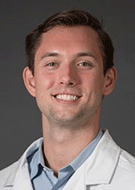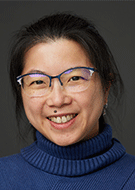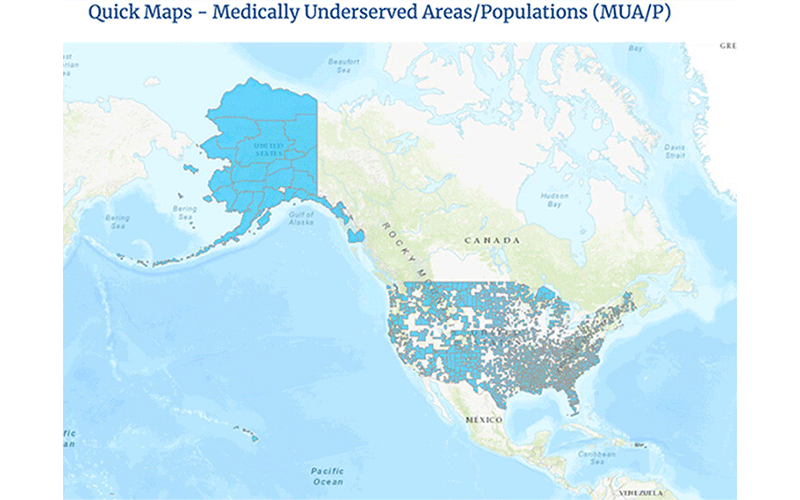Providing Imaging Assistance for the Underserved in Your Community
Radiology trainees can make a difference close to home


U.S.-based radiology trainees interested in working with medically underserved populations (MUPs) often consider traveling internationally to access these opportunities. However, according to a new paper by members of the RadioGraphics Trainee Editorial Advisory Board, radiology trainees can—and perhaps, should—get involved in serving the 3,500 radiologically underserved populations across the U.S.
When discussing the benefits of working with MUPs, lead author John Karp, MBChB, diagnostic radiology resident at Penn Medicine in Philadelphia, explained that projects in one’s own community can provide more constancy for residents.
“When medical residents go overseas, they typically go for a month or longer, and may not be able to go again, whereas interacting with local community members over time can lead to long standing relationships, which can grow and be easier to maintain,” Dr. Karp said.
Co-author Charlotte Chung, MD, PhD, a neurointerventional radiology fellow at NYU Langone Health, New York City, pointed out that local MUP projects can have wider impact because residents can involve more health care staff, particularly from the residents’ own institutions.
“If you're doing something that's local, you can leverage the resources and expertise that are available to you in your institution, such as your co-residents, attendings and techs,” she said.

Map shows the 3574 medically underserved areas (MUAs)/populations (MUPs) that exist in the United States in 2023, according to data from the U.S. Department of Health and Human Resources (1). (Reprinted from reference 1.) https://doi.org/10.1148/rg.230119 ©RSNA 2023
Getting Started
For residents who decide to work with local MUPs, Drs. Karp and Chung recommend becoming familiar with existing initiatives.
“For example. mobile mammography clinics are becoming more accessible and it's something that my institution has previously led in the community, to serve patients who weren't able to get to the hospital or had financial barriers to that service,” Dr. Karp said.
“These clinics always welcome assistance as they are in high demand.”
Another approach is to spearhead a low-cost imaging initiative in your community. When Dr. Chung was a resident at Emory University School of Medicine in Atlanta, she was involved in launching an ultrasound clinic, which is typically less expensive to get off the ground than other types of imaging clinics, such as CT or MR.
To pioneer a successful project, Dr. Chung advised partnering with existing non-profit clinics to reach patients from MUPs.
“There was a non-profit clinic already established next to Emory where there is a large refugee population, so we partnered with them,” Dr. Chung said. “I recommend establishing relationships with clinicians at the non-profit clinics because patients don’t typically show up knowing what imaging study they need or whether they even need to be imaged. There are a lot of logistics involved, particularly when patients need follow-up related to imaging findings, and by developing these partnerships you can provide imaging services over a long period of time.”
Practical Considerations
While working with local MUPs is rewarding, there are legal and privacy considerations that residents must plan for in advance.
For instance, working with patients outside of their residency program requires malpractice insurance, according to Dr. Chung, who explained that there are often state-sponsored programs available to provide this insurance.
“Programs at the state level sometimes offer coverage to providers who work with populations that meet certain income and other requirements,” Dr. Chung said. “For the ultrasound clinic, we identified coverage that protected everyone working onsite.”
To safeguard patient privacy in a project working with MUPs, Dr. Chung recommended that residents work with their IT departments to ensure that their technical processes are HIPAA compliant.
“For example, if you're using a Microsoft account, how do you make sure it is HIPAA compliant? Alternately, if your cloud service is not HIPAA compliant, you may need to use a hard drive or a non-cloud storage solution,” Dr. Chung said.
Creating Long Term, Local Impact on Health Disparities
Although an international project may be alluring, Drs. Karp and Chung encourage U.S.-based radiology residents to consider working with MUPs at home.
Doing so can help residents learn about health equity issues in their own communities.
“When you're working in a more affluent community in an academic center or hospital, you may not be exposed to patients from underserved populations,” Dr. Chung said. “But many local patient populations experience health equity issues and don’t currently receive adequate imaging services.”
Dr. Karp added that radiology residents are poised to make a difference due to their diverse skills that can be applied to yield long-term benefits.
“As radiologists, we are fortunate enough to be not only clinicians, but also diagnosticians and interventionalists, so we have a multitude of skills that we can bring to a community and give back,” Dr. Karp said. “There are many great local programs that not only give the trainee valuable experience, but more importantly, build sustainable, life changing impacts for the community.”
For More Information
Access the RadioGraphics paper, “Helping Medically Underserved Populations: Guide for U.S. Radiology Trainees to Get Involved at Home.”
Read additional RSNA News stories of interest to trainees:
RSNA Announces New Outstanding Community Impact Award
The newly announced RSNA Outstanding Community Impact Award will recognize an individual in the radiological sciences who has made exceptional contributions to patient care and health care delivery through service to the community. The inaugural award will be presented during the RSNA annual meeting in 2024.
Candidates will be identified through open nominations between March 18 and April 30. Nominees must be members of RSNA or AAPM who have demonstrated measurable impact on the community through their leadership and advocacy in the field of radiology. Strong candidates may have a history of enhancing patient care, developing new initiatives, or creating partnerships that resulted in a sustainable impact on the community. Eligible nominees will demonstrate a commitment to RSNA’s mission and values.
The Outstanding Community Impact Award Committee will review candidates and make recommendations to the RSNA Board of Directors, and the Board will select the final honoree.
Learn more about the new award and submit a nomination.